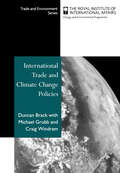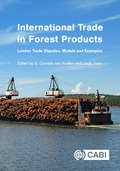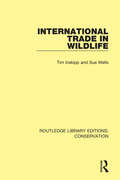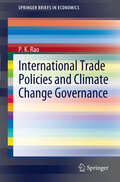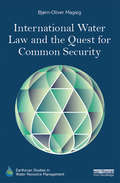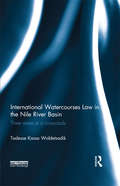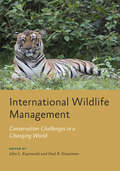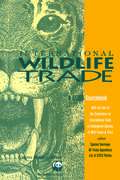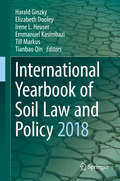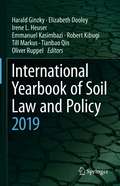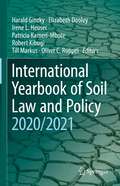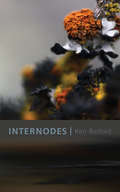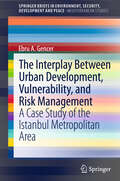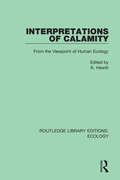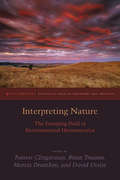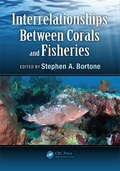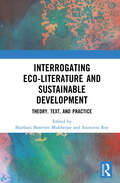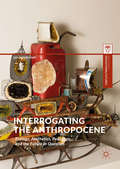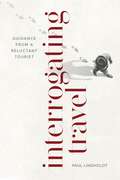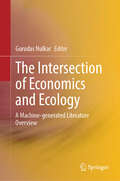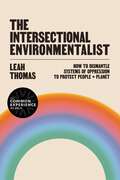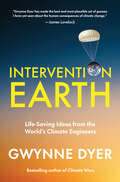- Table View
- List View
International Trade and Climate Change Policies
by Duncan Brack with Michael Grubb and Craig WindramFocusing on the likely impacts on trade of the UN Framework Convention on Climate Change and the Kyoto Protocol, this book examines the actual and potential conflicts between whether liberalization of trade undermines the efforts of industrialised countries to mitigate climate change. It will be essential reading for environmental economists and those engaged in international environmental relations and policy.
International Trade in Forest Products: Lumber Trade Disputes, Models and Examples
by Joseph Buongiorno Jinggang Guo Craig Johnston Xintong Li Fatemeh Mokhtarzadeh Harry Nelson Prakash Nepal Jeffrey Prestemon Brad StennesBecause of the long-standing Canada-U.S. lumber trade dispute and the current pressure on the world's forests as a renewable energy source, much attention has been directed toward the modelling of international trade in wood products. Two types of trade models are described in this book: one is rooted in economic theory and mathematical programming, and the other consists of two econometric/statistical models--a gravity model rooted in theory and an approach known as GVAR that relies on time series analyses. The purpose of the book is to provide the background theory behind models and facilitate readers in easily constructing their own models to analyse policy questions that they wish to address, whether in forestry or some other sector. Examples in the book are meant to illustrate how models can be used to say something about a variety of issues, including identification of the gains and losses to various players in the North American softwood lumber business, and the potential for redirecting sales of lumber to countries outside the United States. The discussion is expanded to include other products besides lumber, and used to examine, for example, the effects of log export restrictions by one nation on all other forestry jurisdictions, the impacts of climate policies as they relate to the global forest sector, and the impact of oil prices on forest product markets throughout the world. This book will appeal to practising economists and researchers who wish to examine various policies that affect international trade, whether their interest is local or international in scope. Because the book provides the theoretical bases underlying various models, students and practitioners will find this a valuable reference book or supplementary textbook.
International Trade in Wildlife (Routledge Library Editions: Conservation #2)
by Tim Inskipp Sue WellsOriginally published in 1979 International Trade in Wildlife is a product of the 1973 Convention on International Trade in Endangered Species of Wild Fauna and Flora conference, containing the full text of the CITIES convention. The volume outlines the animals and plants controlled by CITIES, and describes the protective policies put in place to protect endangered plants and animals. It gives a detailed background to the international traffic in monkey’s, spotted cats, whales, ivory, parrots, tortoises, marine turtles, crocodiles, butterflies, sponges and rare orchids at the time of publication and acts as a comprehensive document on the conservation policies enacted through CITIES, as well as facts surrounding the decline of endangered species. Although published over 40 years ago, the document still offers a comprehensive and useful guide to conservation and will be an important historical document for environmental policy makers and conservationists alike.
International Trade Policies and Climate Change Governance
by P. K. RaoThis work offers a synthesis of the current approaches toward an integration of international trade and climate change, with a view to fostering potential improvements in policies and institutions affecting these. A number of pragmatic measures are proposed with reference to the WTO and the United Nations Framework Convention on Climate Change (UNFCCC) regimes, which are expected to contribute toward enhanced climate change governance, as well as promoting international trade.
International Water Law and the Quest for Common Security (Earthscan Studies in Water Resource Management)
by Bjorn-Oliver MagsigThe world’s freshwater supplies are increasingly threatened by rapidly increasing demand and the impacts of global climate change, but current approaches to transboundary water management are unsustainable and may threaten future global stability and international security. The absence of law in attempts to address this issue highlights the necessity for further understanding from the legal perspective. This book provides a fresh conceptualisation of water security, developing an operational methodology for identifying the four core elements of water security which must be addressed by international law: availability; access; adaptability; and ambit. The analysis of the legal framework of transboundary freshwater management based on this contemporary understanding of water security reveals the challenges and shortcomings of the current legal regime. In order to address these shortcomings, the present mindset of prevailing rigidity and state-centrism is challenged by examining how international legal instruments could be crafted to advance a more flexible and common approach towards transboundary water interaction. The concept of considering water security as a matter of ‘regional common concern’ is introduced to help international law play a more prominent role in addressing the challenges of global water insecurity. Ways for implementing such an approach are proposed and analysed by looking at international hydropolitics in Himalayan Asia. The book analyses transboundary water interaction as a ‘case study’ for advancing public international law in order to fulfil its responsibility of promoting international peace and security.
International Watercourses Law in the Nile River Basin: Three States at a Crossroads
by Tadesse Kassa WoldetsadikThe Nile River and its basin extend over a distinctive geophysical cord connecting eleven sovereign states from Egypt to Tanzania, which are home to an estimated population of 422.2 million people. The Nile is an essential source of water for domestic, industrial and agricultural uses throughout the basin, yet for more than a century it has been at the centre of continuous and conflicting claims and counter-claims to rights of utilization of the resource. In this book the author examines the multifaceted legal regulation of the Nile. He re-constructs the legal and historical origin and functioning of the British Nile policies in Ethiopia by examining the composition of the Anglo-Ethiopian Treaty of 1902, and analyses its ramifications on contemporary riparian discourse involving Ethiopia and Sudan. The book also reflects on two fairly established legal idioms - the natural and historical rights expressions – which constitute central pillars of the claims of downstream rights in the Nile basin; the origin, essence and legal authority of the notions has been assessed on the basis of the normative dictates of contemporary international watercourses law. Likewise, the book examines the non-treaty based claims of rights of the basin states to the Nile waters, setting out what the equitable uses principle entails as a means of reconciling competing riparian interests, and most importantly, how its functioning affects contemporary legal settings. The author then presents the concentrated diplomatic movements of the basin states in negotiations on the Transitional Institutional Mechanism of the Nile Basin Initiative (NBI) - pursued since the 1990’s, and explains why the substance of water use rights still continued to be perceived diversely among basin states. Finally, the specific legal impediments that held back progress in negotiations on the Nile Basin Cooperative Framework are presented in context.
International Wildlife Management: Conservation Challenges in a Changing World (Wildlife Management and Conservation)
by John L. Koprowski and Paul R. KrausmanA call for wildlife conservationists to transcend the boundaries of locality, share best practices, and unite with a common voice to influence global policy.Habitat loss, disease management, predator-human conflict, illegal trade—these are among the many conservation challenges faced by wildlife experts around the world. But how wildlife professionals approach these issues has historically been geographically fragmented. By providing a broad perspective on issues faced by wildlife on an international scale, the authors of International Wildlife Management make vital connections, drawing attention to underlying causes and strategies for mitigation that may look surprisingly similar from Montana to Zimbabwe. Bringing together wildlife professionals from around the globe to discuss shared challenges, International Wildlife Management• examines widespread patterns of wildlife loss• covers key conservation strategies, including species reintroduction, community engagement, and wildlife commerce• explores the urgent concerns of climate change, habitat loss and fragmentation, invasive species, and poaching• reviews major organizations involved in wildlife management at an international level, highlighting examples of cooperation among groups and nations in effective wildlife management efforts• features stories of success and struggle from authors across 17 countries on 6 continents This timely and thorough overview thinks big by assessing threats to wildlife on a global scale. Wild creatures don't recognize artificial geographic borders. This useful compendium demonstrates that researchers and scientists should follow their lead.
International Wildlife Trade: A Cites Sourcebook
by Ginette Hemley Kathryn FullerFor more than two decades, the Convention on International Trade in Endangered Species of Wild Fauna and Flora, known as CITES, has been one of the largest and most effective conservation agreements in the world. By regulating international commerce in certain species -- from African elephants and exotic birds to hardwoods and bulbs -- the treaty limits trade in species that are in genuine need of protection while allowing controlled trade in species that can withstand some level of exploitation.In addition to explaining how CITES operates, this definitive reference includes: the full text of the CITES treatyCITES Appendices I, II, and III a list of Parties as of March 1994 a list of reservations by Parties as of October 1993 Chapters address the status of highly threatened species such as elephants, rhinos, and tigers as well as other heavily exploited species including parrots, primates, and bears.International Wildlife Trade provides a valuable overview of wildlife trade issues, and of the strengths and weaknesses of the current treaty.
International Yearbook of Soil Law and Policy 2018 (International Yearbook of Soil Law and Policy #2018)
by Harald Ginzky Elizabeth Dooley Irene L. Heuser Emmanuel Kasimbazi Till Markus Tianbao QinThis book presents an important discussion on urbanization and sustainable soil management from a range of perspectives, addressing key topics such as sustainable cities, soil sealing, rehabilitation of contaminated soils, property rights and liability issues, as well as trading systems with regard to land take.This third volume of the International Yearbook of Soil Law and Policy is divided into four parts, the first of which explores several aspects of the topic “urbanization and sustainable management of soils.” The second part then covers recent international developments, while the third part presents regional and national reports, and the fourth discusses cross-cutting issues. Given the range of key topics covered, the book offers an indispensible tool for all academics, legislators and policymakers working in this field. The “International Yearbook of Soil Law and Policy” series discusses central questions in law and politics with regard to the protection and sustainable management of soil and land – at the international, national and regional level.
International Yearbook of Soil Law and Policy 2019 (International Yearbook of Soil Law and Policy #2019)
by Harald Ginzky Elizabeth Dooley Irene L. Heuser Emmanuel Kasimbazi Robert Kibugi Till Markus Tianbao Qin Oliver RuppelThis book presents an important discussion on the implementation of sustainable soil management in Africa from a range of governance perspectives. It addresses aspects such as the general challenges in Africa with regard to soil management; the structural deficiencies in legal, organizational and institutional terms; and specific policies at the national level, including land cover policies and persistent organic pollutants.This fourth volume of the International Yearbook of Soil Law and Policy is divided into four parts, the first of which deals with several aspects of the theme “sustainable soil management in Africa.” In turn, the second part covers recent international developments, the third part presents regional and national reports (i.a. Mexico, USA and Germany), and the fourth discusses cross-cutting issues(i.a. on rural-urban interfaces). Given the range of key topics covered, the book offers an indispensible tool for all academics, legislators and policymakers working in this field.The “International Yearbook of Soil Law and Policy” is a book series that discusses central questions in law and politics with regard to the protection and sustainable management of soil and land – at the international, national and regional level.
International Yearbook of Soil Law and Policy 2020/2021 (International Yearbook of Soil Law and Policy #2020)
by Harald Ginzky Irene L. Heuser Oliver C. Ruppel Elizabeth Dooley Till Markus Robert Kibugi Patricia Kameri-MboteThis book presents an important discussion on land tenure rights for the effective implementation of sustainable soil management provisions. It investigates a variety of aspects, such as the clash of modern and traditional tenure concepts, forms of illegal or illegitimate land acquisition, and the preconditions for legal and legitimate investments. In addition, the book analyses the challenges to ensuring secure land tenure rights in Africa and in Germany. Lastly, it provides information on the role of women in this context.This fifth volume of the International Yearbook of Soil Law and Policy is divided into four parts, the first of which deals with various aspects of the theme “Land Tenure Rights and Sustainable Soil Management”. The second part covers recent international developments, the third part presents regional and national reports, and the fourth discusses overarching issues. Given the range of key topics covered, the book offers an indispensable tool for all academics, legislators and policymakers working in this field.The “International Yearbook of Soil Law and Policy” series discusses central questions in law and politics with regard to the protection and sustainable management of soil and land – at the international, national, and regional level.
International Yearbook of Soil Law and Policy 2022 (International Yearbook of Soil Law and Policy #2022)
by Harald Ginzky Fabiano De Andrade Corrêa Elizabeth Dooley Irene L. Heuser Patricia Kameri-Mbote Robert Kibugi Oliver C. RuppelThis open access book presents an important discussion on the interface between sustainable soil management and climate mitigation and adaptation. It investigates a variety of aspects in this context, such as the political and societal consequences for countries in the Global South, an assessment of the outcomes of the UNFCCC Conference of Parties held in Glasgow, appropriate legal instruments to promote desealing, regulatory concepts for negative emissions in soil and land use, the debate in Europe on carbon uptake in soils and the climate-related policy of the Convention on Biological Diversity. Lastly, it provides information on recent court rulings on climate mitigation in Germany and Australia and their relevance for sustainable soil management.This sixth volume of the International Yearbook of Soil Law and Policy is divided into four parts, the first of which deals with various aspects of the theme “Climate Mitigation and Adaptation and Sustainable Soil Management.”The second part covers recent international developments, the third presents regional and national reports, and the fourth discusses overarching issues. Given the range of key topics covered, the book offers an indispensable tool for all academics, legislators and policymakers working in this field. The “International Yearbook of Soil Law and Policy” series discusses central questions in law and politics with regard to the protection and sustainable management of soil and land – at the international, national, and regional level.
Internodes
by Ken Belford BelfordMoving with nomadic grace across the terrain of his previous book, Decompositions, the poetic language of Ken Belford in Internodes shares similar roots, traversing decades at the speed of a search query - pressing onward through Hazelton, the Bulkley Valley, and the unroaded head-waters of the Nass River in the Damdochax Valley - and meanwhile coming to terms with a poetry that "is lived" on the rugged streets of Prince George.In this twenty-first-century evolution, and one may say "mutation," of Marshall McLuhan's oft-repeated adage that "the medium is the message," Belford's text takes into account the nature of viral marketing and the impact of similar forms of social "trending" on our lives and our language, challenging linearity and order in favour of a work that may be read forward or backward or experienced with an abrupt sense of intimacy, in media res.Whether reflecting upon the internodal segment that is a vital part of a nerve cell; upon the relationship between the nodes and internodes of a plant stem; or upon the internode merely as an interstice of jargon amid connections we forge through high-speed telecommunication and wireless networks, the text invites the reader to make an informed decision before inviting others to "Like," to "Favourite," or to otherwise invest their social currency in Internodes.In addition to perceiving the poem as the "means of transmission" over time, Belford's poetic lines welcome readership as a form of collaborative action and agency in an age of crowdsourcing and flash mobs - and also as a form of ongoing social process that is sensitive to the life and demise of many of the decision trees that ultimately nourish our wavering notions of the future.
The Interplay between Urban Development, Vulnerability, and Risk Management
by Ebru A. GencerNatural disasters are increasingly affecting the world, taking lives unexpectedly and leaving many others injured and homeless. Moreover, disasters disrupt local, national and even global economies, instantly changing the direction of development. In the first half of 2011 alone, 108 natural disasters occurred, killing over 23 thousand people, affecting nearly 44 million others and causing more than 253 billion US dollars of economic damages (CRED 2011,1). Large urban settlements have become increasingly vulnerable to the impacts of natural disasters. The concentration of substandard infrastructure and housing, material assets, and inherent socio-economic inequalities increase vulnerability to disasters in large urban areas, especially in developing countries. The size, number, functions, and geographical distribution of large- and megacities create a special concern for disaster risk. Good urban management practices can be a powerful catalyst for reducing losses from natural disasters, while simultaneously helping to develop a sustainable environment. Yet, the existing situation indicates that sustainable planning and risk management measures are not taken into consideration or may not be put into practice for a variety of financial, political, and social reasons. This book argues that, on one hand, socio-economic disparities resulting from unsustainable urban development can increase vulnerability to natural hazards, and on the other hand, when paired with natural hazards this increased vulnerability can negatively affect urban areas, resulting in further inequality. This book will showcase this argument with theoretical reviews and quantitative analyses on the interplay between sustainable development and disaster vulnerability as well as an in-depth case study of the role of urban planning and risk management practices in creating the socio-economic and spatial vulnerabilities and predicted earthquake risk in the megacity of Istanbul.
Interpretations of Calamity: From the Viewpoint of Human Ecology (Routledge Library Editions: Ecology #4)
by K. HewittOriginally published in 1983, Interpretations of Calamity provides a provocative critique of the ‘dominant view’ of research into natural hazards. Throughout the world, there are now many people professionally engaged in the mitigation and control of risks & hazards, and the impact of continuing economic development will ensure that they are fully employed. There is a wealth of perspectives in the book, including weather and wheat yields in the Soviet Union and Canada, an historical view of underdevelopment and hazards in Ireland and the impact of a response to drought in southern Africa, the Sahel and the Great Plains of the USA. The book reflects the major themes of hazards in the context of economic development and social change. Most of the case studies are from the rural and agriculture scene. This book provides a unique view of the vital importance of food production and of the considerable, and sometimes calamitous, impact that frost, flood, storm and drought have on the wellbeing of millions of people and on the stability of the international economic system.
Interpreting Nature: The Emerging Field of Environmental Hermeneutics (Groundworks: Ecological Issues in Philosophy and Theology)
by Brian Treanor Martin Drenthen David UtslerModern environmentalism has come to realize that many of its key concerns—“wilderness” and “nature” among them—are contested territory, viewed differently by different people. Understanding nature requires science and ecology, to be sure, but it also requires a sensitivity to history, culture, and narrative. Thus, understanding nature is a fundamentally hermeneutic task.
Interrelationships Between Corals and Fisheries
by Stephen A. BortoneInterrelationships Between Corals and Fisheries is derived from a workshop held by the Gulf of Mexico Fishery Management Council in Tampa, Florida in May 2013, where world authorities came together to discuss the current problems in managing tropical fisheries and offered suggestions for future directions for both researchers and environmental reso
Interrogating Eco-Literature and Sustainable Development: Theory, Text, and Practice
by Sharbani Banerjee Mukherjee and Soumitra RoyThis book examines the issues of ecological crisis and sustainable development through critical reading of literary texts. By analysing writings of Rabindranath Tagore, Amitav Ghosh, Gerard Manley Hopkins, Hannah Arendt, and Lawrence Buell, it discusses themes like oriental representations of ecological consciousness; environmental evocations; misogyny and its postmodern creations; tracing nature’s footprints in English literature; statelessness and consequent environmental refugees; ecocriticism and comics; and, absolute trust in the goodness of the earth. The volume argues that within the ambit of debates between ecological threats and socio-economic concerns, culture plays a vital role particularly in relation to parameters such as identity and engagement, memory and projection, gender and generations, inquiry and learning, wellbeing and health. This book will be of interest to scholars and researchers of cultural studies, English literature, social anthropology, gender studies, sustainable development, environmental studies, ecological studies, development studies, and post-colonial studies.
Interrogating the Anthropocene: Ecology, Aesthetics, Pedagogy, And The Future In Question (Palgrave Studies In Educational Futures Ser.)
by Jan JagodzinskiThis volume weaves together a variety of perspectives aimed at confronting a spectrum of ethico-political global challenges arising in the Anthropocene which affect the future of life on planet earth. In this book, the authors offer a multi-faceted approach to address the consequences of its imaginary and projective directions. The chapters span the disciplines of political economy, cybernetics, environmentalism, bio-science, psychoanalysis, bioacoustics, documentary film, installation art, geoperformativity, and glitch aesthetics. The first section attempts to flesh out new aspects of current debates. Questions over the Capitaloscene are explored via conflations of class and climate, revisiting the eco-Marxist analysis of capitalism, and the financial system that thrives on debt. The second section explores the imaginary narratives that raise questions regarding non-human involvement. The third section addresses ’geoartisty,’ the counter artistic responses to the speculariztion of climate disasters, questioning eco-documentaries, and what a post-anthropocentric art might look like. The last section addresses the pedagogical response to the Anthropocene.
Interrogating Travel: Guidance from a Reluctant Tourist
by Paul LindholdtNever in human history has travel been so accessible to so many. But—amid an escalating climate crisis that threatens the homes of vulnerable people across the world—has the human cost of trekking the globe become too high? Paul Lindholdt links firsthand narratives with research about the travel trade, telling stories of his reluctant voyages while arguing that carbon-intensive trips abroad may be offset if adventurers come to know and love the landscapes closer to home. Tourism may be the planet’s largest industry, but Interrogating Travel advises readers to stay mindful of the consequences of their journeys, whether visiting local getaways or some of Earth’s most remote locations.
Intersecting Realities of Health Resilience and Governance in India: Emerging Domestic and Global Perspectives
by Shantesh Kumar SinghThe book delves into the intricate interplay between health resilience and governance in the context of India, providing a thorough examination of critical domestic and international issues. It examines the multifaceted challenges faced by India concerning the health of its populace, the impacts of nonconventional security concerns, and the effectiveness of governance mechanisms in addressing these issues. With a multidimensional lens, it analyses the convoluted connections between health outcomes and multiple factors, shedding light on the complex web of health risks. Moreover, it critically evaluates the existing governance frameworks in India, assessing their strengths and weaknesses in dealing with the complex domestic and international challenges posed by the intersection of health and other emerging nontraditional security issues. It synthesizes extensive research and empirical data, presenting a nuanced understanding of the current scenario and exploring innovative solutions and policy recommendations. This book investigates valuable domestic and international perspectives and provides insights to diplomats, foreign and domestic policymakers, researchers, and practitioners by addressing research gaps and understanding within the realms of health resilience and governance in India. It serves as a foundational resource for comprehending the dynamics of these issues in the Indian context, offering a roadmap for creating resilient, sustainable, and equitable policies that can safeguard public health amidst the domestic and international challenges of an evolving governance structures in India.
The Intersection of Economics and Ecology: A Machine-generated Literature Overview
by Gurudas NulkarThis book is a machine-generated literature overview highlighting the importance of natural capital while studying the economics of ecology. It puts together available literature on this theme exploring it through the lens of sustainable development. While the main content is machine-generated, each chapter contains curated published content overview and an introduction by the editor, highlighting important areas and literature gaps, describing the connection of the topic with human economy, and examples of negative externalities. The topics seek out research articles that show a connection with mainstream economy, or rural livelihoods.The connection between natural capital and human economy, is well-known, but many of these negative externalities are complex problems to solve. While there is a growing awareness to capture the value of natural capital in economic decision-making, there is no universal consensus. However, assessing the economic value of naturalresources and ecosystem services, and integrating this information into decision-making processes such as cost-benefit analysis, corporate reporting, and government policy-making, holds a promise of finding long-term solutions to these market failures. By valuing natural capital, decision-makers can better understand the economic benefits and costs of different activities and policies, and make more informed choices that balance economic, social, and environmental objectives. Containing important introductions by the human editor to plug gaps in literature, the book is a great resource for policy-makers, students of economics and sustainable development, non-governmental organisations working in this field, and corporate managers who are responsible for allotting budgets towards corporate social responsibility programs.^
The Intersectional Environmentalist: How to Dismantle Systems of Oppression to Protect People + Planet
by Leah ThomasFrom the 2022 TIME100 Next honoree and the activist who coined the term comes a primer on intersectional environmentalism for the next generation of activists looking to create meaningful, inclusive, and sustainable change. The Intersectional Environmentalist examines the inextricable link between environmentalism, racism, and privilege, and promotes awareness of the fundamental truth that we cannot save the planet without uplifting the voices of its people -- especially those most often unheard. Written by Leah Thomas, a prominent voice in the field and the activist who coined the term "Intersectional Environmentalism," this book is simultaneously a call to action, a guide to instigating change for all, and a pledge to work towards the empowerment of all people and the betterment of the planet. Thomas shows how not only are Black, Indigenous and people of color unequally and unfairly impacted by environmental injustices, but she argues that the fight for the planet lies in tandem to the fight for civil rights; and in fact, that one cannot exist without the other. An essential read, this book addresses the most pressing issues that the people and our planet face, examines and dismantles privilege, and looks to the future as the voice of a movement that will define a generation.
The Intertidal Wilderness: A Photographic Journey Through Pacific Coast Tidepools
by Anne Wertheim RosenfeldThe Intertidal Wilderness is a stunning photographic exploration of the tidepools of the Pacific coast, from Baja California to as far north as southeast Alaska. These lush photographs capture in striking color the enormous variety of life and biological detail in the intertidal zone along one of the world's most spectacular coastlines.
Intervention Earth: Life-Saving Ideas from the World's Climate Engineers
by Gwynne DyerHistorian, journalist, and author Gwynne Dyer interviews the world&’s top 100 climate scientists to discuss the extraordinary measures we must contemplate to counter the irreversible effects of climate change.The global climate emergency is now an alarming fact of life. Much as we still need to get emissions under control, many are thinking that it's all too little, too late. As scientists, politicians and concerned citizens scramble for solutions to the catastrophic effects of a warming world, is it time to be exploring the controversial topic of geoengineering?For decades, discerning readers have turned to journalist and historian Gwynne Dyer for his unparalleled acumen in serving up hard geopolitical truths. Intervention Earth is built around Dyer&’s interviews with one hundred climate scientists from around the globe, including the leading figures in the geoengineering field. One of the most interesting topics: the pros and cons of Solar Radiation Management, a possible planetary Hail Mary that is rife with political risks.But Intervention Earth is about more than technological mega-projects. Dyer devotes ample space to the many innovative ideas on offer, but there is no get-out-of-jail-free card. We will need a whole portfolio of techniques and technologies—and a lot of hard, thankless work—to keep the planet hospitable for humanity.What&’s more, many of the technologies that can help us avoid the worst outcomes require years of investment and development before they can be successfully deployed. Global cooperation will be key in implementing the life-saving strategies outlined in the book. With up-to-the-minute, breaking-news reporting Intervention Earth offers a probing, eye-opening look at the problems we face, and the innovations that just might keep us ahead of encroaching disaster and carry us to a safe harbour.
